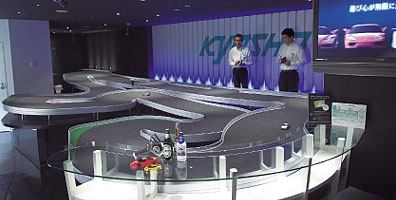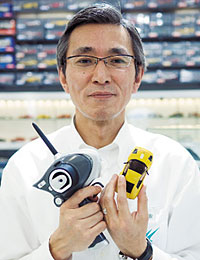Special Feature![]() Exploring Akihabara, Japan’s Electronic Market
Exploring Akihabara, Japan’s Electronic Market
Wireless racetrack speeding
Kyosho Akihabara is a “rajikon circuit café” launched by Kyosho Corporation, a major manufacturer of miniatures. The café is on floor B1 in the Akiba Tolim Building.
Mini-cars and rajikon (radio-wave-controlled) cars are displayed all over the place. At the back is the racetrack. Choose the car you like best, and make her go. Tea, alcohol and other beverages are available at the counter beside the track.
“We wanted a place that would appeal to hobbyists. They come to enjoy themselves, not just to buy,” says the store manager, Udo Shoichi.
Once beginners learn the basics from the staff, they get down to some thrilling rajikon speeding. The number of female “wireless drivers” is on the rise.

The track is for a new type of racing car built to the scale of 1:43. This is the same as the scale for the track, so the visual effect is quite realistic. “We wanted the mini-cars to look like the real thing on the race track,” says the store manager at Kyosho Akihabara, Udo Shoichi. You can rent a car and run it on the track (500 yen for 15 minutes).

The first make-it-yourself robot store in Japan
Tsukumo Robot Kingdom opened in August 2000 and since Day 1 customers have kept coming and coming. It was the first store to specialize in make-it-yourself robots. Here you will find robot components and kits for making two-legged walking robots.
The kits used to cost several hundred thousand yen, but today they may go for less than 100,000. And robot performance is far better now. They run, jump, do a forward roll, skip rope, even kick a soccer ball. You can try out the latest robotic fancy moves on the store’s small interior soccer field.
“We’re getting a lot more customers in their 50s and 60s. And of course people who were keen on rajikon (radio-wave-controlled) cars when they were young,” says the store manager, Arai Sadahiro.

